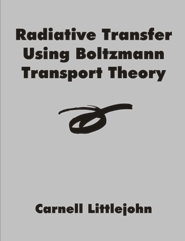
Radiative Transfer Using Boltzmann Transport Theory
by Carnell Littlejohn
- Number of Pages: 114
- ISBN-10: 158112256X
- ISBN-13: 9781581122565
- Publisher: Dissertation.com
- Year: 1998
- Category: Mathematics, Mathematics
Synopsis
Radiative transfer of photons though a random distribution of scatterers is considered. The Boltzmann transport eq is used to develop a program to obtain real values of intensity based on a set of discrete time intervals. A Newton-Raphson method is used to determine a set of eigenvalues based on the boundary conditions and system geometry. A numerical method due to Lanczos is used to approximately invert a Laplace transform. The algorithm is designed for easy modification to more general problems.
PART II: Eigenvalues for the intensity distribution from the one speed Boltzmann transport equation can be
computed using an iteration method with the roots and coefficients for the zeros of the Legendre
polynomials and the results converge to the known values based on a Newton-Raphson method used
in an earlier treatment for a radiative transfer . A spherical harmonic expansion of the intensity and
the application of laplace and finite fourier transforms was used to solve the problem . The zero of a
transcendental equation based on the differential equation for the boundary conditions was approximated
for the eigenvalues . A Newton-Raphson method was used . Here an iteration method is used with the
Legendre polynomials and the results are identical to the Newton-Raphson results therefore the Legendre
polynomials can be used to compute the eigenvalues for the intensity distribution . A S16 approximation
of the intensity distribution using Fast Fourier Transforms for the coefficients of the interpolating
polynomial is given . The program for the coefficients is from a standard Numerical Methods text (Burden
and Faires, 1993, Chap.8, p. 309). Arctans from the approximation are compared with the Newton-Raphson
eigenvalues.



 View or Post a Review at Amazon.com
View or Post a Review at Amazon.com